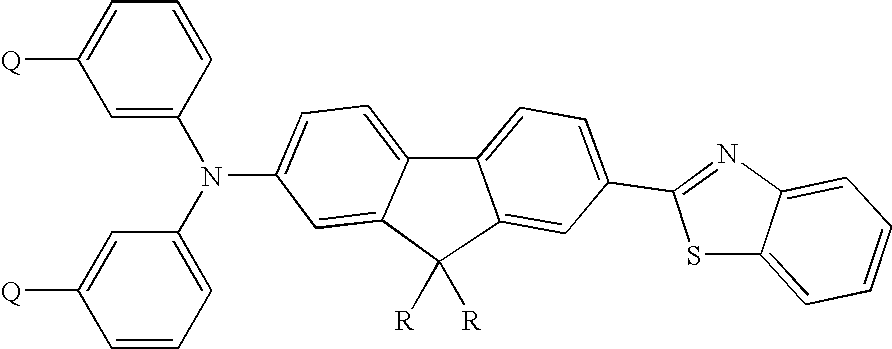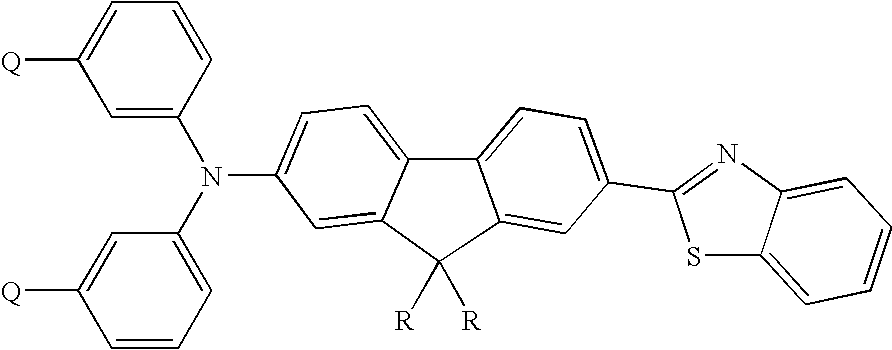Thermally cross-linkable two-photon chromophores
a chromophores and cross-linking technology, applied in the field of chromophores, can solve the problems of largely dormant field
- Summary
- Abstract
- Description
- Claims
- Application Information
AI Technical Summary
Benefits of technology
Problems solved by technology
Method used
Image
Examples
example 2
9,9-Diethyl-2,7-dibromofluorene
[0012]To a mechanically stirred mixture of 2,7-dibromofluorene (66.5 g., 0.205 mol.), powdered potassium hydroxide (56.0 g., 1.0 mol.), potassium iodide (3.4 g.) and DMSO (150 ml), cooled to 10° C., ethyl bromide (40 ml, 58.4 g. 0.536 mol.) was added dropwise over 45 minutes. The mixture turned from red to light purple. After allowing the temperature to warm to 20° C., the mixture was left overnight to stir and poured into water, 77.0 g (98.7% yield), m.p. 144-153° C. The product was then recrystallized from hexane (550 ml) With charcoal treatment, and collected in two crops, m.p. 154-157° C. and 153-154° C., totaling 60.36 g. (77.4% yield).
example 3
9,9-Diethyl-7-bromo-fluorene-2-carboxaldehyde
[0013]To a mechanically stirred solution of 9,9-diethyl-2,7-dibromofluorene (59.38 g., 0.1563 mol.), in THF (325 ml), cooled in dry ice-ethanol bath, n-butyl lithium (104 ml of 1.6M solution in hexanes, 0.1664 mol, 1.06 eq.) was added dropwise over 25 minutes. After 20 minutes, DMF (17 ml, 0.22 mol.) in THF (30 ml) was added, and the mixture was stirred in the cooling bath for 1.5 hours, and outside the bath for 1 hour. The reaction was then cooled to 5° C., and treated with hydrochloric acid (12.5 of concentrated hydrochloric acid diluted with 50 ml water). The mixture was diluted with 200 ml of toluene, and the aqueous phase was separated and extracted with 200 ml of toluene. The combined organic phase was washed with dilute sodium bicarbonate solution, dried over magnesium sulfate and concentrated. The residual solids were recrystallized from heptane-ethyl acetate (9:1), to get colorless solids, 40.29 g. (78.4% yield) m.p. 126-128° C. ...
example 4
2-(7-Bromo-9,9-diethylfluoren-2-yl)benzothiazole
[0014]A mixture of 9,9-diethyl-7-bromo-fluorene-2-carboxaldehyde (49.35 g., 0.15 mol.), 2-aminothiophenol (20 ml. 0.187 mol., 1.25 eq.), and DMSO (110 nl) was heated in an oil bath to a bath temperature of 195° C., held there for 45 minutes, and then poured into water. The separated solids were collected, reslurried in 1:4 acetic acid-water (1000 ml.) filtered, and washed with water and dilute sodium bicarbonate solution. These solids, 80.05 g., were then reslurried in hot ethanol, (600 ml), cooled and filtered to get the product benzothiazole, 45.69 g., m.p. 133.6-135° C. An additional 6.6 g., m.p. 134.6-135.5° C., was obtained by chromatography of the ethanol filtrate. Total recovery was 52.29 g. (80.3% yield). Mass Spec: m / z 433, 435, (M+). Anal. Calcd for C24H20BrNS: C, 66.37; H, 4.64; Br, 18.40; N, 3.23; S 7.37%. Found: C, 66.46; H, 4.52; Br, 18.54; N, 3.14; S, 7.19%.
PUM
| Property | Measurement | Unit |
|---|---|---|
| mol % | aaaaa | aaaaa |
| mol % | aaaaa | aaaaa |
| temperature | aaaaa | aaaaa |
Abstract
Description
Claims
Application Information
 Login to View More
Login to View More - R&D
- Intellectual Property
- Life Sciences
- Materials
- Tech Scout
- Unparalleled Data Quality
- Higher Quality Content
- 60% Fewer Hallucinations
Browse by: Latest US Patents, China's latest patents, Technical Efficacy Thesaurus, Application Domain, Technology Topic, Popular Technical Reports.
© 2025 PatSnap. All rights reserved.Legal|Privacy policy|Modern Slavery Act Transparency Statement|Sitemap|About US| Contact US: help@patsnap.com



